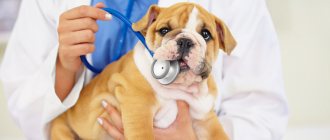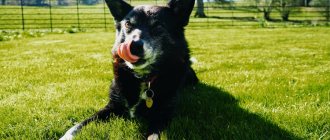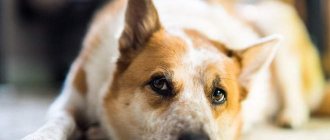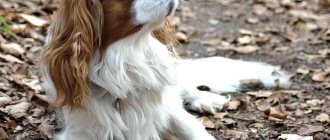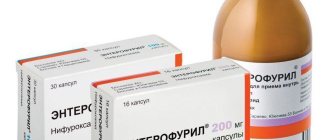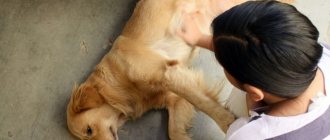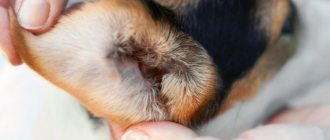Volvulus is a pathology caused by twisting of the digestive organs, blocking the passage to the intestines. The disease develops rapidly and requires immediate surgical intervention. It is important for all dog owners to know how to identify a problem by the first symptoms, how to treat and prevent the disease.
Read an important article on the topic: “What to do if your dog has a hernia: symptoms with photos, treatment recommendations.”
Volvulus in dogs
Intestinal volvulus (stomach) in dogs is a severe pathology, characterized by twisting of the digestive organs with complete closure of the passage to the intestines. It occurs suddenly and develops rapidly; treatment is strictly surgical, so at the first sign of discomfort in the dog, the owner must take the pet to the veterinary clinic within no more than an hour.
Causes
Obesity, a sedentary lifestyle, and chronic constipation are factors that provoke the development of intestinal obstruction in dogs. They increase the severity of symptoms, and also make the clinical picture even more vivid and noticeable.
Among the main causes of intestinal obstruction in dogs:
- Poor nutrition.
Bones, hard-to-digest veins, low-quality meat, missing foods are some of the factors that can cause intestinal obstruction. This is due to the fact that solid parts of food can close the lumen of the digestive tube.
- Eating disorder.
If the pet starved for a long time (for example, did not have access to food for 2-3 days or more), and then received a large portion of food, then intussusception is possible, i.e. the introduction of one part of it into the lumen of another.
- Entry of foreign objects into the gastrointestinal tract.
By mistake, a dog may swallow inedible objects (for example, sewing supplies, rags, stones, plastic bags, parts from a toy construction set). Young pets who pick up trash on the street are at particular risk.
- Diseases caused by parasitic worms.
Helminthic infestations provoke mechanical blockage of the intestines and the inability to move products through it. The most widespread are tapeworms, as well as the nematodes Toxascaridis leonina, which parasitize the intestines.
- Various pathologies.
Among them: benign and malignant neoplasms, peristalsis disorders, diseases of the gastrointestinal tract, etc. They can lead to dynamic intestinal obstruction in dogs.
Why does bloat occur?
Part of the culprit for the occurrence of bloat is the dog owner himself. Factors predisposing to volvulus are:
- Poor nutrition. Bulk food, mainly consisting of carbohydrates, ferments quickly, provokes an increase in the volume of the stomach and intestines, and is poorly digested.
- Feeding food at once, in one go.
- Prolonged fasting, and then giving food. In this case, the dog quickly swallows food, capturing a large amount of air (dysphagia).
- Feeding before a walk. This is a colossal mistake by the owner; the dog is given food only after it has taken a walk and after physical activity.
- Malfunction of the central nervous system.
Large breed dogs (shepherd dogs, Great Danes, etc.) are predisposed to intestinal (stomach) volvulus, which is explained by their specific skeletal structure and deep chest.
When the intestinal loops and stomach are greatly increased in volume, they can move freely in the abdominal cavity. When a dog suddenly jumps, jumps, or simply turns over from side to side, the digestive organs are displaced and twisted around their axis. A closed cavity appears in which the digestion process continues, but there is no outlet for the resulting gases and food. The intestinal loops stretch, compressing nearby organs and vessels.
Gastric volvulus. Typically, gastric volvulus occurs in dogs of large breeds: St. Bernards, Giant Schnauzers, German and East European Shepherds, Russian Greyhounds, Setters, Rottweilers. Most often, Great Danes die from bloat, sometimes entire litters.
Scientific developments in recent years have shown that much depends on the dog’s body type. Thus, in the work of researcher Larry Glickman, it was found that dogs with certain characteristics of the chest are clearly predisposed to volvulus. Several thousand dogs were measured at the American National Dog Show. Almost 30% of animals at risk died from gastric volvulus or underwent surgery in the first year.
The nutritional factor also plays a significant role. Many dogs “sit” on thin porridges, soups, food that is unnatural for dogs. Such nutrition easily leads to fermentation processes, against the background of which bloat can occur. Many owners do not follow the diet: they walk with a dog that has eaten, feed large amounts at a time. A dog returning from a walk should not eat immediately; it needs to rest for at least thirty minutes. Gastric volvulus is one of the most common causes of death among dogs in security kennels. The dog is brought from the post, heartily fed with stew and left in the enclosure. And then a dog or cat wanders past, a stranger wanders into the territory. The dogs jump up, jump around the enclosure, and rush. And in the morning, kennel workers discover another dead dog.
Volvulus involves twisting the stomach around its axis, usually 180′. This almost never happens to humans: their stomach and spleen are rigidly fixed by ligaments. And dogs have a weak suspensory apparatus of the stomach, a horizontal position of the body of the stomach. Hence the reason - excessive physical stress on the stomach leads to bloat.
Symptoms of the disease associated with gastric volvulus are as follows: bloating of the abdomen as a result of expansion of its walls by accumulated gases, difficulty breathing due to disruption of the diaphragm, ending in painful shock. In dogs with painful shock and respiratory failure, surgery must be performed with artificial ventilation during massive therapy.
In summer, gastric volvulus occurs catastrophically quickly. Due to the heat, fermentation processes begin very soon, the stomach swells with gases, is deprived of blood supply, necrosis (death) of the stomach wall and spleen occurs and, as a rule, the dogs die in the next 2-3 hours. In winter, the situation is somewhat easier: we had a case where, thanks to surgery, a dog survived after bloat five hours ago.
During the operation, the stomach is inverted. If it is viable (the wall has not undergone necrosis), it is sutured to the walls of the abdominal cavity. In such operations, it is always recommended to remove the spleen, and in severe cases, part of the stomach. Of course, dogs after gastric volvulus and surgery need to be treated for a long time, kept on a diet, and nutrition adjusted.
Recently, cases of bloat have become more frequent. When the stomach volvuls, the dog bloats before our eyes. As some owners note, “the dog is growing by leaps and bounds.” A very important symptom is the urge to vomit, but usually there is no vomiting as such. There is vomiting of foam - the so-called esophageal vomiting. The dog swallows saliva, but it does not reach the stomach due to the fact that its cardiac (anterior) section is twisted. When the urge occurs, vomiting of the contents of the esophagus occurs. In addition to the stomach, the intestines also swell - after all, the autonomic nervous system and solar plexus are involved in the process, and the dog begins to experience intestinal paresis. It happens that when gas is partially released through the esophagus and through the rectum, the dog is slightly “deflated.” She feels a little better, the owners calm down, but this state is deceptive.
Pre-volvulus states occur: for several days the dog’s stomach swells, then spontaneously deflates. This condition is classified as an incomplete volvulus, which straightens itself. The end is always the same - sooner or later a complete volvulus occurs. Therefore, it is better to immediately bring the dog to the doctor and undergo preventive surgery. You can’t hesitate here: gastric volvulus is a fatal disease, there is no self-healing. First aid for this disease: give the dog an injection of painkiller (analgin, baralgin) and immediately take it to the clinic; nothing else will help. If transportation is delayed, you can try to release the air from the stomach with a thin, long needle.
The main diagnostic method is x-ray. If the image shows that the stomach and intestines are distended, then the dog immediately goes to the operating table.
Intestinal obstruction. Dogs sometimes swallow things that boggle the mind. Traditionally, these are small buttons, needles, bones and their fragments, and rubber toys. Once a Great Dane swallowed a strict collar along with a leash. In addition to foreign bodies stuck in the digestive tract, obstruction can be caused by helminthic infestation (more often in puppies), or adhesions after abdominal surgery.
Symptoms of obstruction are usually vomiting, lack of bowel movements, and abdominal bloating or tenderness. The higher the degree of obstruction, the more intense its manifestations, especially vomiting, and at first it can be in the form of stomach contents and mixed with bile. Later, when the obstruction lasts more than 5-6 days, vomiting is continuous. It is not related to food intake. The dog is vomiting intestinal contents with the smell of feces. If there is an obstruction in the lower parts of the digestive tract (in the large intestine), there may be no vomiting, but the dog is bothered by the urge to defecate without the appearance of feces; mucus and blood may be released from the rectum.
With obstruction, dehydration of the body occurs, loss of large amounts of salts and protein. Dogs lose weight before our eyes, instantly lose weight. The owners say: “She has lost twice the weight.”
If you do not consult a doctor in a timely manner, the dog dies from intoxication and volemic blood disorders (disorders associated with changes in blood volume): due to the loss of protein and fluid, the heart works worse and worse, and arrhythmia begins. And of course, dogs die when necrosis of the intestinal wall develops (it ruptures) and subsequent peritonitis. With fecal intestinal peritonitis, the prognosis is extremely unfavorable. Although dogs do not react to peritonitis like humans, and their defenses are better developed, the mortality rate reaches 60-70%.
A foreign body can get stuck in any part of the gastrointestinal tract. There was a case where a bull terrier had a bone stuck in the thoracic esophagus. I had to remove the bone through the chest. Foreign bodies get stuck in the pylorus (the part of the stomach at the transition to the duodenum), in the duodenum itself, at the transition of the small intestine to the large intestine, etc. But the vast majority of foreign bodies get stuck, of course, in the small intestine.
If treated in a timely manner, the operation consists of cutting the intestinal wall and removing the foreign body. After the operation, the dog recovers before our eyes, the next day begins to ask to drink and eat, and quickly comes to its senses. It is more difficult if you have to perform a resection (removal of part) of the intestine. If a foreign body is stuck in the esophagus, then after the operation you have to completely exclude food, otherwise healing will not be successful.
As a rule, intestinal obstruction is treated for anything: hepatitis, gastroenteritis, poisoning, etc. They just don’t realize to carry out a simple diagnostic procedure - an X-ray examination with a contrast agent. A Doberman was recently brought to our clinic after being treated elsewhere for hepatitis. And the dog is getting worse and worse; they simply brought him here. X-rays taken with contrast showed a foreign body in the middle of the small intestine. During the operation, I had to perform a resection of the intestine, removing 30 cm, since the area was dead. The dog recovered, but we can say that she still got off happily.
Intussusception, the invasion of a section of intestine into an adjacent section of the gastrointestinal tract, also causes intestinal obstruction. Most often, intussusception occurs in puppies and very young dogs; in our practice, there were only 1-2 cases in adult animals. The most common cause of intussusception is an imperfection in the structure of the intestine: the layers of its walls are very mobile relative to each other. Very active peristalsis can lead to intussusception, which again happens more often in young dogs. Other reasons include helminthic infestation and improper feeding. One day, a dog was brought to the clinic with such intussusception that the small intestine came out through the rectum. Upon examination, it became clear that this was not just prolapse of the rectum - the structure of the mucous membrane was not typical for the large intestine, the folds were not the same. And the dog was immediately taken for surgery, during which the diagnosis was confirmed. If treated promptly, a dog with intussusception can still be cured. If time is lost, then a bowel resection has to be done.
If there are symptoms of intestinal obstruction (vomiting, abdominal pain, stool and gas retention, weight loss), examination of the sick animal should be standard. To clarify the diagnosis, it is necessary to take an x-ray with a contrast agent, sometimes an ultrasound, which shows antiperistaltic (directed against the natural course) intestinal movements. If a doctor neglects the diagnostic rules, patients often die.
Tumors. Among the catastrophes in the abdominal cavity, the presence of tumor bodies should be noted. The most common tumor in dogs is the spleen. The tumor, having reached a certain size, can rupture with careless movement or a blow to the dog’s stomach. Bleeding occurs in the abdominal cavity, sometimes fatal - they don’t even have time to take the dog to the clinic. I recently had a shepherd dog at my appointment - a seven-year-old black male. They brought him in with complaints of severe, sudden weakness. Just now he was cheerful, never sick, a strong, healthy dog. On examination, the mucous membranes are pale, even white, body temperature is 37°C (as is known, with bleeding, the temperature decreases), vomiting. Ultrasound shows a huge amount of fluid (like blood) in the abdominal cavity. We urgently open the abdominal cavity and find a ruptured tumor of the spleen. The tumor had grown to a considerable size, and with an unsuccessful jump it simply ruptured. The dog lost a lot of blood, it was necessary to receive blood transfusions from other dogs, since autotransfusion (returning one’s own lost blood into the circulatory system) in case of tumor rupture cannot be carried out under any circumstances. In general, it took a lot of effort to save the shepherd.
Continuing the conversation about neoplasms, it should be noted that owners usually learn about tumors when they reach an extreme stage and begin to interfere with the normal functioning of the body. Not long ago, an eight-year-old bull terrier was brought to the clinic with signs of partial intestinal obstruction. The dog periodically vomited, she lost weight, but some of the food still passed through the intestines. The condition worsened gradually over a long period of time. During the operation, a tumor was discovered that had grown through all layers of the intestine. Despite such a terrible diagnosis, the dog recovered, and during the examination we did not find any distant metastases.
Pyometra. Among the most common diseases, endometritis (inflammation of the uterus) should be noted. There are times when not a day goes by in our clinic without surgeons removing 34 uteruses. The nature of the course distinguishes between acute and chronic purulent endometritis. Chronic can last for years, but will definitely end in pyometra.
Pyometra is hyperplasia (growth) of the uterine mucosa, the accumulation of infected secretions in it, and the cervix closes and sticks together. Not everyone pays attention to the fact that the dog becomes lethargic, loses weight, begins to drink a lot, but thirst is almost always a sign of intoxication. Small discharge appears, but mostly exudate and pus accumulate in the uterus. With a closed cervix, the dog's belly gradually increases in volume. These are typical manifestations of pyometra. Almost always, the development of endometritis is associated with hormonal status, or rather, with its imbalance. In approximately 80% of cases, the onset of the disease occurs in the period after estrus during the so-called false whelping, that is, about a month and a half to two months after emptying. Endometritis also occurs during estrus or immediately after it. Dogs often have cysts in the ovaries, which also stimulate the development of purulent endometritis.
A disaster could strike at any moment. Sometimes this is severe intoxication, when the liver, kidneys, heart, and lungs “sit down.” Sometimes - uterine rupture, leading to purulent peritonitis. In addition to the operation to remove the uterus and ovaries, you have to install a bunch of drains to flush the abdominal cavity. In such cases, the treatment is very long, the dogs are literally dragged from the other world. In order not to cause the disease, you need to monitor your pets. Any “unhappy” condition of a dog over 5-6 years old is a reason to visit a doctor. We must remember about the possible development of endometritis, in which thirst and polyuria (increased urination) are sometimes the only symptom. To clarify the diagnosis, it is necessary to conduct an ultrasound examination. The absence of such diagnostics can lead to very interesting cases. So, just recently a basset hound was sent to us from another clinic for a puncture due to ascites. The belly of this short-legged dog was huge, but for some reason it was not round, as with ascites, but with uneven protrusions. And even upon palpation (palpation), something lumpy was detected. They sent the dog for an ultrasound, and the result left everyone somewhat confused: the Basset had no ascites, but a huge inflamed uterus was detected. After the operation, the removed uterus was weighed; it “pulled” by 6.5 kg - almost a third of the basset’s weight. It remains a mystery how such a diagnosis was made. Obviously, by eye. And we could be happy for the dog: it was only a miracle that her uterus did not rupture, everything could have been much worse. As follows from the above, in order not to miss the development of the process, bitches should periodically undergo an ultrasound of the abdominal cavity, since now there are no obstacles to carrying out such an examination. To prevent pyometra, it is advisable to sterilize a non-breeding bitch after her first heat. And breeding - at 5-6 years, after the end of her career as a producer. By the way, sterilization also serves as a prevention of breast cancer.
Injuries. Many dogs present from car accidents with a combination of injuries, such as a broken limb and signs of a crash in the abdomen. Surgery on a limb can always be done; it can also be postponed, unless, of course, the fracture is open. First of all, you need to deal with the abdominal injury. During operations, ruptures of the liver, ruptures of the spleen with massive bleeding, separation of the intestine from the mesentery, bleeding from the mesenteric vessels, and rupture of the bladder are discovered. It should be noted that bladder rupture is one of the most common causes of accidents in the abdominal cavity. There are also such cases: the dog was driven away, hit in the stomach, and he just left the house and did not even have time to lift his paw. As a result, the bladder ruptured due to the hydrocompression shock. Ruptures may also be associated with asymptomatic urolithiasis (USD), which is more common in male dogs. But at some certain point, stones clog the urethra in narrow places (for males - near the bone of the penis), and become lodged in the neck of the bladder. Acute urinary retention occurs. The dog does not urinate or urinates drops and blood. Any careless movement, jump, or blow can lead to a rupture of the bladder. Owners bring dogs with complaints of lack of proper urination: urine leaks out drop by drop or bleeds. In addition, the dog has abdominal pain. The abdomen becomes like stone due to irritation of the peritoneum due to urinary peritonitis. The diagnosis is established by ultrasound results. During the examination, the bladder is not identified (it must be at least two by three centimeters in size), and there is an accumulation of a large amount of fluid in the abdominal cavity. Usually in such cases, an emergency operation is performed, layer-by-layer suturing of the mucous and muscular lining of the bladder, and sometimes resection of the wall in case of a complex rupture. Dogs in this condition need drainage of the abdominal cavity; with peritonitis there is no escape from this.
Dogs also come in with penetrating wounds - in times of peace! Injuries are accompanied by severe damage to the liver, stomach, intestines, and other organs. The more different injuries, the more serious the treatment and, unfortunately, the worse the prognosis.
Quite often they bring in small dogs that have been in the teeth of their larger brothers. Such incidents are accompanied by severe injuries in the abdominal cavity: ruptures of the liver, ruptures of the kidneys, ruptures of the bladder, ruptures of the intestines from the mesentery. A large dog grabs a small one across the body - and in addition to spinal injuries and broken ribs, damage to internal organs is added.
In our clinic, one Pekingese was operated on three times because it got into the teeth of a large dog. They saved three times, the fourth was the last. So he was unlucky, and he got some strange owners. Well, you shouldn’t let small dogs near large ones, the consequences can be very sad.
Thrombosis of mesenteric vessels. Thrombosis of mesenteric vessels is quite rare and no one knows the causes of its occurrence. This year there have been 34 cases. With thrombosis, intestinal gangrene develops instantly, and nothing can be done to help the dog.
Recently, my friends German Shepherd died. She was operated on for intussusception as a child, twice. Everything was fine, but three or four years later a thrombosis occurred. Symptoms of thrombosis are typical signs of intestinal obstruction. But if a dog with classic intestinal obstruction can live without help for several days, slowly losing fluid, etc., then thrombosis has a lightning-fast course, like a gastric volvulus.
The dog is bloated, first of all, due to swollen intestinal loops, the abdomen is unevenly enlarged, it is asymmetrical. Vomiting appears, first with gastric contents, in later stages - coffee grounds with the smell of decomposition. The pain syndrome is pronounced, due to intestinal necrosis, very severe intoxication occurs. To clarify the diagnosis, an x-ray is taken. An x-ray reveals an intestine that is filled with gases and intestinal contents. Thrombosis of the mesenteric vessels is a very fast-acting disease; after 4-5 hours, as a rule, there is nothing to do.
It is believed that thrombosis can occur due to errors in diet. A massive meal can lead to torsion of the mesentery of the small intestine, since the intestine is a fairly mobile structure, and thrombosis occurs instantly. Even if the intestines unfold, the vessels are already injured. I once operated on a dog with this diagnosis, and I had to open the superior mesenteric artery, since there was no blood flowing to it: the blood clot was located from the aorta and below. The superior mesenteric artery supplies blood to the entire intestine, and by the time the dog arrived at the clinic, it had already turned black. In such a situation, it is useless to do anything, and the dog is euthanized. Even if a change in a dog’s condition is noticed in a timely manner, this disease is 100% fatal. We tried various methods, including vascular surgery, but the tissue cannot be restored - after 2 hours the intestine dies.
Acute pancreatitis (inflammation of the pancreas) is very rare in dogs. During my practice, there were 15-20 cases of pancreatitis, but only six dogs survived.
In acute pancreatitis, dogs present with symptoms such as repeated vomiting, pain, a tense, rocky stomach, and retention of stool and gas. In this case, the dog is immediately taken for surgery, during which signs of acute pancreatitis are discovered. First of all, these are plaques of necrosis of adipose tissue throughout the peritoneum, and throughout the omentum - steatonecrosis. With necrosis of the pancreas, a huge amount of enzymes are released that destroy adipose tissue. Self-digestion occurs, leading to erosive bleeding. Treatment is not possible without surgical intervention, as extensive enzymatic peritonitis occurs. The most common cause of death is intoxication, accompanied by the development of shock and acute renal failure. The diagnosis is made on the basis of x-rays and the results of a rapid urine test (one of its parameters changes hundreds of times, so it’s difficult to make a mistake). Treatment requires good drainage, as well as intensive therapy, administration of albumin, protein, cytostatics (5-fluorouracil), aminocaproic acid, enzyme inhibitors - such as gordox, contrical, trasylol.
Gastrointestinal bleeding most often occurs against the background of stress ulcers, which can occur both during psycho-emotional overload and during serious illnesses. Bleeding can also occur due to chemical poisoning. For example, after drinking caustic soda, a dog receives a chemical burn to the gastrointestinal tract and erosive bleeding. Dogs can eat something (usually bones) and damage their intestines with sharp edges. Excessive use of medications, especially non-steroidal anti-inflammatory drugs, can also cause bleeding. Oh, how some therapists love them: they use Voltaren, indomethacin, and reopirin without restriction, forgetting that these drugs can cause erosions and ulcerative disorders. In addition, steroid hormones have a destructive effect. If you get too carried away with the same dexamethasone, you can easily achieve an ulcer with the development of bleeding, and sometimes perforation (through damage to the walls of the stomach or intestines).
Ulcerative disorders are diagnosed during gastroscopy, sometimes even several ulcers are detected in the dog.
Symptoms depend on which parts of the gastrointestinal tract are bleeding. A sign of bleeding from the stomach is vomiting the so-called “coffee grounds”. Under the influence of hydrochloric acid produced by the stomach, red blood cells are destroyed and the vomit turns brown. As a rule, this accompanies stress ulcers and the condition after gastric volvulus. After volvulus, bleeding usually occurs due to erosive-ulcerative changes, so the stool remains black for a long time. In this case, appropriate therapy is prescribed: drugs that suppress gastric secretion, such as histodil, cimetidine, as well as enveloping agents (almagel, flax seed decoction), astringents (buckthorn decoction, oak bark), wound healing agents (solcoseryl, trichopolum).
Bleeding from the lower intestine is characterized by brighter, cherry-colored blood appearing in your dog's stool. When intestinal bleeding is combined with diarrhea, the stool becomes bright red, regardless of the height of the bleeding site. The appearance of unchanged blood in the stool is usually associated with bleeding from rectal polyps, from cracks in the mucous membrane during diarrhea, injury from sharp bones, etc. By the way, rectal tumors are very common: cancer, submucosal lymphomas, cancer of the perianal area. But all this is visible bleeding. The main sign of bleeding from the upper sections, particularly the small intestine, is black, tarry stool (melena). If such a stool appears in a dog, then this may be due to helminthic infestation, a disintegrating tumor, ulcerative bleeding, or simply banal enterocolitis of allergic origin.
Owners should pay attention to changes in the color of their pet's stool. At first, the bleeding may bother the dog slightly, but when it becomes unwell, it may be too late. This is how the Rottweiler died after surgery. He had a perforated duodenal ulcer with peritonitis that developed two days ago. The dog had to be sutured for an ulcer. They nursed him for a month, but they failed to save him.
Strangulated hernias. Strangulated hernias also occur in dogs. The most dangerous thing for a dog is an internal abdominal hernia, when internal organs get into the folds of the peritoneum, and the owners do not even suspect its existence. There are diaphragmatic hernias of the intestine. There was a case of a hernia in a dog, when half of the intestine protruded into the chest cavity and lay in front of the heart. The ultrasound did not detect the intestines, and in general it was not clear where it was? The introduced contrast also did not go anywhere. During the operation, the abdominal cavity was opened - there was no intestine. They began to do an inspection - they found the stomach and “went” through the small intestine. And she enters through the strangulated hernial ring into the chest cavity and almost all of it has climbed in there. Of course, the dog felt according to the diagnosis, all the signs of intestinal obstruction were observed.
There have been a surprising number of perineal hernias lately. Hernial protrusions emerge from one or both sides, into which the entire rectum is folded. The dog has difficulty defecating, bulges appear around the anus, which are sometimes simply gigantic. After all, the omentum, intestines, prostate gland and, worst of all, the bladder get there, since in this case its wall may be pinched. One day, the owners of a mongrel dog came to the clinic. So, her hernia was almost bigger than the dog itself. The causes of a hernia are weakness of the pelvic floor, prostatitis, chronic constipation (the dog has to constantly push). In uncomplicated cases, the operation consists of plastic surgery of the hernial orifice. There is no need to wait for infringement: if you see it, come to the doctor. Fortunately, now they can operate well, without relapses. Inguinal hernias are quite common. Recently there was such a case: a black terrier’s endometritic uterus came out through a hernial ring. There was a huge formation under the skin; at first they thought it was a tumor. But during the operation it turned out that there was a uterus there.
Due to dirty, careless operations, postoperative hernias occur. Due to infection, the sutures on the muscles come apart, and half of the intestine may come out under the skin. When muscles contract, pinching occurs.
In puppies, both inguinal and umbilical hernias need to be operated on at three to four months. At this age, the operation takes place without complications, and the best cosmetic effect is achieved.
When a hernia is strangulated, as already mentioned, symptoms of obstruction appear. Owners pay attention to vomiting, retention of stool and gas, weight loss, and painful hernial protrusion may appear. The general condition of the dog worsens. The animal becomes lethargic, does not eat anything, or eats, but immediately vomits. Body temperature decreases. With intestinal obstruction, the temperature begins to rise with the development of peritonitis. The dog has a loss of strength, why should there be a temperature, because the body begins to “eat” itself, hence the weight loss.
There is no way to prevent this type of disease; you just need to see a doctor in time. It is better to wake everyone up due to a false alarm than to destroy the dog by being too calm.
Inversion of the horn of the pregnant uterus. An unsuccessful movement or jump can lead to a similar condition. The animal is in an extremely serious condition, symptoms of an acute abdomen are observed: vomiting, extremely painful abdomen, pale skin, rapid and weakly filled pulse. With gangrene of the enfolded horn, exudate leaks into the abdominal cavity and peritonitis begins. Emergency surgery to remove the uterus can save the animal's life.
The owner must first of all pay attention to the behavior of his dog. They cannot tell us anything, but a change in the animal’s condition, anxiety or apathy should not go unnoticed. And one last thing. If everything is not all right with the dog and there are suspicions of abdominal diseases, it is strictly not recommended to apply heating pads, give enemas, force water or feed the dog. Even the administration of analgesics and antispasmodics can mask and distort the picture of an acute surgical disease. There is no need to experiment: if the diagnosis is not clear, it is better to consult a doctor and conduct a standard examination. There is no need to think about it, go to the clinic.
Dmitry Eremin - deputy. Chief Physician of the Center for Emergency Veterinary Care, Friend magazine
Significant mistakes of owners
Among dog breeders, it is customary to feed large dogs with cereals, bread, and canteen waste. They add the “smell of meat” to them, often in the form of boiled pork skins, lard, bones, etc. All of these are prohibited foods for dogs, a time bomb, and if your pet’s diet consists of 80-95% cereal and only up to 20% meat by-products, you urgently need to change the type of food.
Important! A dog is a carnivore and in the wild its diet consists of 95-97% meat, and it is muscle tissue, fascia, and ligaments that are used. Skin, interior fat, bones, etc. dogs are left to scavengers.
High content of grain feed, incl. and dry food, where the basis is wheat and corn, coupled with improperly organized walking, provokes the development of intestinal volvulus by 80-85%. It is especially dangerous if an animal receives a bowl of porridge with the smell of meat after a long hunger strike. By swallowing food along with air, it provokes the development of dysphagia and increases the likelihood of intestinal (stomach) distension.
Normally, gases formed during the digestion of a food coma and a small amount of air are released through belching or through the anus. Part of it is absorbed by the walls of the digestive tract.
If you feed your dog food with starch, grain, and gas-forming vegetables (cabbage, potatoes), this is a direct path to the development of bloat. You also need to exclude industrial feeds that contain more carbohydrates than meat (protein).
Rehabilitation after surgery
After surgery, careful monitoring of the pet's condition is necessary. A fasting diet is recommended for the first 24 hours. Make sure your pet has free access to clean and fresh water. Then broth and liquid porridge are gradually introduced into the diet. The main thing is to feed your pet in small portions.
In parallel, parenteral nutrition is used. Plasma substitutes and nutritional components in the form of solutions are administered intravenously to the dog. A course of antibiotics is prescribed, which must be given to the pet at the same time to prevent the development of a surgical infection. In addition, it is necessary to monitor the progress of recovery and undergo repeated ultrasound examination.
Other features of rehabilitation after surgery:
- 14 days after the operation, it is necessary to include fermented milk products (low-fat cottage cheese, yogurt, kefir) in the diet,
- gradually you need to introduce oatmeal and buckwheat porridge, as well as boiled vegetables, with the exception of potatoes and cabbage,
- it is important to ensure complete rest for the dog, even short walks on a leash are allowed no earlier than 7-10 days after the intervention,
- the duration of walks after receiving permission from the veterinarian must be increased gradually: from 5-10 minutes or more,
- Additionally, immunomodulators and mineral-vitamin complexes are prescribed to improve the pet’s condition after the intervention.
Risk factors
Owners of dogs over 20 kg and with a deep chest (calculated using an x-ray, the ratio of the width and depth of the chest) need to be especially careful. If the coefficient is more than 1.4, the dog is at risk.
Factors provocateurs:
- A small amount of digestive enzymes that prevent food coma from being digested well and provoke increased gas formation.
- Chronic diseases of the gastrointestinal tract, in which the intestinal walls contract poorly and push/digest food.
- Tumors in the gastrointestinal tract.
- Sphincter pathology, stenosis, spasms, scarring, etc. This prevents the food ball from being evacuated correctly.
The proper functioning of the intestines depends on the functioning of the central nervous system (neuro-humoral system), it regulates the digestion process and responds to failure by releasing enzymes, acids, etc. Failure at any stage of the promotion/digestion of a food coma triggers a number of changes regarding the proper functioning of the intestines, sphincters, and stomach .
Important! Low atmospheric pressure increases gas formation in the gastrointestinal tract, even with the right diet. Stress during feeding can cause bloat, so it is strictly forbidden to take food away from a dog, frighten it while eating, or otherwise create a stressful situation.
Typical signs of bloat
The first symptoms appear within 30-40 minutes, very rarely – up to 2 hours. The main sign is the suddenness of the manifestation, just a couple of minutes ago the dog was cheerful, and then the following symptoms appear in increasing order:
- Severe anxiety.
- Change of posture, unnatural body position, the pet tries to find a position that alleviates the condition.
- The urge to vomit, excessive salivation without the release of stomach contents.
- Lack of stool when trying to defecate.
- The abdomen is swollen, the skin is stretched.
- The sounds of peristalsis are not heard.
Torsion of intestinal loops is always accompanied by compression of blood and lymphatic vessels; it is especially dangerous when the mesentery is involved in the process. The blood and lymph supply to the organs stops, the dog’s skin and mucous membranes become bluish-pale, and shortness of breath appears. Coordination of movement is impaired when large vessels and nerve trunks are compressed.
Dangerous symptoms
The development of pathology is accompanied by signs to which the animal owner must pay close attention and react quickly.
Bloating
The condition is always accompanied by one striking symptom indicating pathology - severe bloating. As soon as one part of the stomach changes its position, gases and liquid accumulate in the organ, and blood circulation is disrupted. The tissues swell and die rapidly.
State of shock
The dog goes into shock due to severe pain when arteries and veins are compressed in the peritoneum. The blood vessels narrow, the blood supply to the organs is completely disrupted, the stomach increases in size many times over, putting pressure on the diaphragm.
Similar pathologies
Compression of the diaphragm during gastric volvulus leads to respiratory failure, arrhythmia and other cardiac complications. The symptoms of the pathology and the transience of their manifestation are similar to myocardial infarction or coronary artery disease.
Diagnosis and treatment
It is important for the dog owner to remember that hours pass from the onset of the first signs to death. The veterinarian is given a maximum of 3-4 hours to help, sometimes less than an hour. That is why, if a bloat is suspected, the dog is taken to the clinic immediately; it is advisable to warn the doctor while on the way that they are transporting a pet that may require urgent and complex surgery.
To confirm the diagnosis, fluoroscopy, ultrasound of the abdominal cavity, and sometimes a gastrogram with a contrast agent are performed.
In case of volvulus, the only treatment is surgical; you need to straighten the intestinal loops and fix them in the anatomically correct position. At the same time, all internal organs and large vessels are inspected, tears, foci of necrosis, etc. are eliminated.
First aid for a pet
If a dog breeder manages to recognize volvulus in his pet, he needs to take the animal to the veterinarian as soon as possible. To alleviate your pet's condition, you can give him the following painkillers:
- Baralgin in a dosage of 0.1 ml of the drug per 1 kilogram of animal weight. The medicine is administered intramuscularly. The drug quickly relieves intense pain, but gives a short-lived effect.
- Ketonal at a dosage of 1 mg per kilogram of live weight. Allows you to alleviate your pet's condition for a day. It can be used if you live far from a veterinarian and cannot deliver your dog to him promptly.
- Carprofen. Used in a dosage of 0.2 mg per kilogram of weight, administered intramuscularly once a day. The medicine has a pronounced antipyretic and anti-edematous effect.
It is strictly forbidden to use the following medications to stabilize the animal’s condition:
- Activated carbon. In this case, it will simply get stuck in the pet's stomach.
- Laxative. Drugs of this type will only aggravate the pet’s condition, putting extra stress on the intestines.
- Vasoconstrictors. They do not give a pronounced effect due to the general disruption of the circulatory system during volvulus.
It is also prohibited to use any folk remedies to treat your pet: rubbing, herbal decoctions, lotions. Trying to help using such methods, the dog breeder will only waste precious time and increase the risk of death.
Prevention
It is forbidden to feed dogs, especially large ones, high-carbohydrate, bulky foods. Giving bread, especially sourdough, moldy or spoiled food. Cabbage, legumes, and fruits in large quantities are also not desirable; they can only be given as a treat or in a small percentage of the main food (meat). Canteen waste, skins, fat, etc. are completely eliminated.
Also, feeding the dog should not be meager; there should be enough time between meals so that the pet gets hungry, but does not greedily swallow the food.
Walking, playing, and physical activity after feeding are strictly prohibited. Walk either before feeding or after 2 hours.
